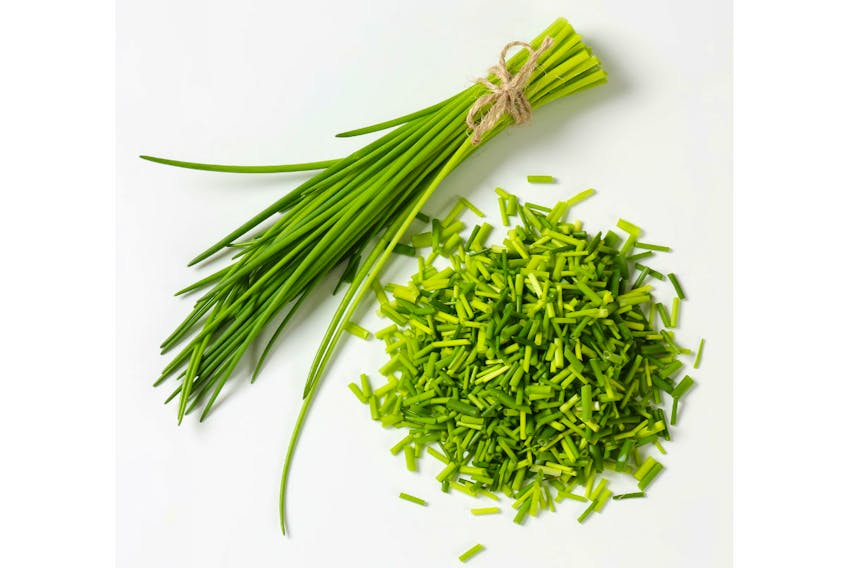
I think it’s possible that I was introduced to the flavour of chives via sour cream and chives potato chips.
However, there is more to this easy-to-grow herb than crunchy snacks.
There are two common chives: onion chives with tubular green leaves, mauve flowers and a mild oniony taste and garlic chives with flat leaves, white flowers and a flavour resembling that of garlic.
According to Rolland (“The Cook’s Essential Kitchen Dictionary”, Robert Rose Inc., 2014), 17th-century herbalist Nicholas Culpeper warned against consuming chives. “If eaten raw, they send up very harmful vapors to the brain, causing troublesome sleep and spoiling the eyesight,” said Culpeper.
He, it seems, was an outlier in his opinions about chives.
Chives have been used for centuries in Europe and Asia. The ancient Greeks were, Rolland says, “heavy consumers of fresh chives”. Believing that strong-tasting chives enhanced physical strength, ancient Romans fed chives to racehorses, wrestlers and workers.
People in China used garlic chives, also called Chinese chives, for both culinary and medicinal purposes. They have been part of Chinese cuisine since 3000 BCE and have been cultivated in China for more than 2000 years. Medically, they were used as an antidote to poison and a medication to stop bleeding.
You could keep evil spirits at bay by bordering the garden with chives or hanging them over the doorway to your home, according to an old British tradition.
No longer confined to Europe and Asia, chives have naturalized in Australia and North America as well. I’ve read that they are now found in every continent, but it seems unlikely to me that there are chives growing in Antarctica.
While the aim for modern dairy farmers is to avoid off flavours in their cows’ milk, early Dutch settlers in the U.S. planted chives in pastures so that their cows would produce chive-flavoured milk for making cheese.
Clumps of chives growing, without any human assistance, on our property provide all the chives we can use from early spring until late fall. Those who don’t have a source of fresh chives can start with a small clump from an existing plot and grow them in an herb garden or border, a container garden or planter.
If you are purchasing chives for cooking or garnishing, seek out ones that are shielded from light because, whether fresh or freeze-dried, they are sensitive to light.
Chives are often used as garnishes for soups and salads, baked or mashed potatoes, eggs, fish or chicken, as they look great and add a pleasant mild flavour. The mauve flowers of chives are also attractive as garnishes.
If you are using chives in cooked foods, add them near the end of the cooking period for best flavour.
Chives, along with chervil, parsley and tarragon, are a component of the classic French blend called fines herbes. To make 15 mL (1 tbsp) of homemade fines herbes, combine 3 mL (¾ tsp) each finely chopped fresh chervil, fresh chives, fresh tarragon, and fresh parsley (Joachim, David: “The Food Substitution Bible. Robert Rose Inc., Toronto, 2010.
Stirred into soft butter, with a squeeze of lemon juice if you like, snipped chives make a tasty spread for sandwich bread, or a finish for vegetables. A suggested proportion is 15 mL (1 tbsp) chopped chives to 50 mL (¼ cup) soft butter but make it to your own taste. The mixture can stirred by hand or blended using a mortar and pestle or a blender.
For ease of use and nice presentation, you can shape chive butter into a cylindrical roll, and cut off a slice when ready to use. Make herb bread to serve with your next barbecue by spreading chive butter on a split baguette and grilling or warming in the oven. It’s also good with lightly cooked fresh asparagus.
For preservation, chives can be chopped and frozen in ice cube trays with a little water. Chopped chives can be mixed with soft breadcrumbs and frozen to use as topping for casseroles.
Drying them is not on my agenda because freeze-drying is the best way to preserve the flavour and colour in dried chives, and that’s a commercial process, not accessible in the home. I suppose I should be hanging a few bunches of them overhead to keep our home safe though.
Margaret Prouse, a home economist, can be reached by writing her at RR#2, North Wiltshire, P.E.I., C0A 1Y0, or by email at [email protected].









